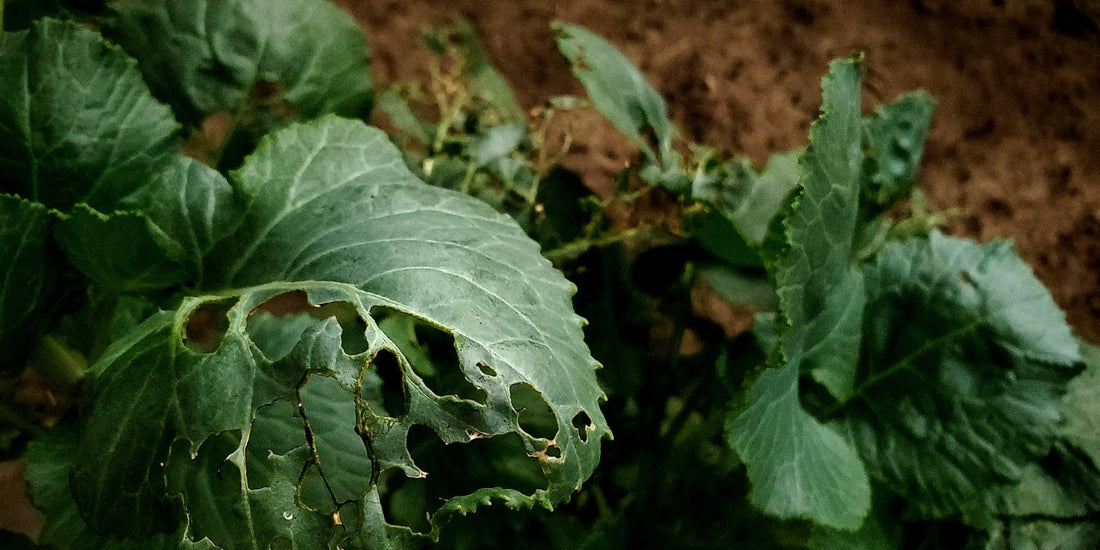Environmentally friendly gardening series: a guide to natural pest and disease control
Introduction
At some point or another, every gardener faces the perils of seeing their plants and trees become victims of pests and diseases. We get a lot of calls and emails about pests and diseases and so this section of the blog is designed to help you eradicate these issues whenever possible and prevent pests and diseases from attacking your trees and shrubs the natural way.
With most pests and diseases, there are numerous ways to prevent them and destroy them. There are natural methods that often involve encouraging wildlife higher up the food chain to feed on pests, or to use netting to protect your fruit from being eaten. There are also biological methods, such as dispersing parasitic nematodes (small parasites) to find and destroy bugs like Vine Weevils. If both natural and biological methods fail then you could try chemical methods, but we are focusing on environmentally friendly gardening methods in this series of blogs.
Preventing a problem is always better than trying to cure a problem and thorough maintenance of your garden is one of the best ways to keep your trees and shrubs disease-free.
Vine Weevil Otiorhynchus Sulcatus

The black vine weevil is a very common pest which attacks over 100 types of plants. The adults are small black bugs that eat away at foliage during the night; the foliage has irregular holes and notches in it when the adults have been feeding on the leaves. Although the adults make your leaves look unsightly, they do not cause any real harm to the tree itself. The adults are very hardy and clever little pests as they ‘play dead’ when they sense a threat, but they are not the real problem, the larvae are the real issue. The larvae live in the soil surrounding the tree and they feed on the roots. The small, white, maggot-like larvae eat away at the roots until they are completely destroyed. Often, people only realise that there is an issue when their tree blows over in the wind as the hollowed roots cannot support the tree any longer, and sadly by this point it is too late. If you are looking out for the signs though, you can stop the Vine Weevils before they destroy your tree or shrub, look out for:
-
Small holes and notches in the foliage as a sign of the adults feeding
-
A sudden deterioration in the health of your tree, with leaves looking limp
-
Your tree looking like it is dry, despite getting plenty of water
-
Small white eggs on the surface of the soil during August
Prevention of Vine Weevils
As with most pests, prevention is often the key to protecting your tree or shrub.
Vine Weevils cannot fly, but they do have an extremely good grip and can sleep upside down and crawl up vertical surfaces with ease. Adult Vine Weevils sleep during the day and come out to feed and lay eggs at night; they frequently sleep on the undersides of potting benches or greenhouse shelves during the day so that they have easy access to plants by night. You can create a barrier to stop the adults from getting to your plants by putting PVC tape around the pot and then coating the tape with organic grease band or organic insect barrier glue. The glue stops the adults from climbing up to the plants to eat the leaves and lay eggs, so this is the best way to prevent them from getting to your trees and shrubs. If your tree or shrub is planted in the ground then you have two options depending on the age of the bark: if the tree is still young then apply tape to the bark and the apply the barrier glue on top of the tape; if the tree is more mature then you can apply the glue directly to the bark (in accordance with the manufacturer’s instructions). You should also note that grease band and barrier glue will also protect your trees against ants, earwigs and winter moths.
Natural Control for Vine Weevils
Many people enjoy attracting birds to their garden anyway, but insectivorous birds will seek-out vine weevils and other pests, so lure them into your garden with hanging feeders and provide nesting boxes for them to occupy over spring. This simple and natural method is surprisingly effective, but many people choose to use this alongside a biological method as an extra precaution.
Biological Control for Vine Weevils
Vigilance is the key here, and if you see adults around your plants then it is possible that eggs are on the roots. Keep a particularly close eye on the roots during august when they lay their eggs and if you see any eggs or maggots then treat the soil with parasitic nematodes. These little parasites are completely harmless to your plants, to humans and to pets, but they seek out Vine Weevils and other pests and enter their bodies through natural openings like their mouths, quickly killing them. When you purchase them, they usually come in a packet with powder, and you mix the powder with water and apply to the base of the tree.
As a precautionary measure, most people choose to regularly apply the nematodes to their soil, and the best thing about this treatment is that the nematodes reproduce and seek out to find and destroy more and more pests including whiteflies, greenflies and blackflies.
Powdery Mildew
What to look out for:
-
White, powdery patches of fungus that spread on the leaf surface
-
In some cases the entire leaf is covered in white fungus
-
Grey/white powder on the stems or flowers
-
If left, the leaves can turn yellow/brown and curl
The good news:
Powdery mildew is very easy to treat and treatments are widely available. This fungus is also host specific, which means that finding it on a particular plant does not necessarily mean that it will spread to any surrounding plants. You can see powdery mildew on a tree below and the mildew here has affected both the stem and the leaves.
Preventing Powdery Mildew
Using techniques to prevent mildew should always be your first thought, particularly if the air is humid in spring and autumn. Powdery mildew thrives in moist conditions and although you cannot change the weather, you can change the growing conditions of your tree or shrub. You can discourage the growth of fungal infections by pruning back any densely packed branches, which ensures that the tree has a good supply of air flowing through it, thus making it harder for the mildew to grow. Make sure that you do not plant your trees in heavily shaded areas and provide ample space between trees and shrubs for good air circulation.
Treating Powdery Mildew
Of course, sometimes despite your best efforts to prevent a disease, it affects your tree anyway. You can make your own treatment for powdery mildew by following either of these simple home-remedies:
-
Mix 1 part Neem oil with 2 parts water and spray liberally onto the leaves
-
Mix 1 part cow’s milk with 9 parts water and spray on to the leaves and the stems; reapply after rain
Slugs
Slugs aren’t always a gardening enemy and they can speed up the process of composting if they are busying themselves in your compost heap (click here for our guide to composting). However, slugs can cause lots of damage to leaves, stems and flowers so slug control is necessary in most gardens. Look out for unsightly holes in the leaves (as pictured) and the giveaway silver slime trails, although the slime trails aren’t present.Prevention
Believe it or not, your watering schedule is one of the most effective ways to control slugs. Slugs are most active at night and they relish damp conditions so watering your plants at night only encourages slugs to come out. Instead, water your plans in the morning and then the surface soil will be nice and dry by the evening.
Another great way of preventing slugs is to create a barrier out of copper. Copper tape can easily be purchased from your local garden centre and you can either place the strips around the base of the plant/tree or you can create a barrier around the border of the bed. The strips work by giving the slug a small electric shock when it comes into contact with the copper and it also acts as a physical barrier too. Copper strips are non-toxic and they are long-lasting and weatherproof. Do ensure that you don’t have any over-hanging leaves or branches though, as these can act as a bridge for the slug to climb over.
Treatment
Killing slugs by drowning them or using chemicals is not an environmentally friendly way of treating a slug problem; instead, we would recommend introducing natural predators like slow worms, beetles and centipedes. You can click here to access an article from The Guardian that gives you information about encouraging these natural predators to your garden.
Although it was once thought that using salt was a good method, we would not advise this. Salt may well kill the slug, but it also adds salt to your soil which doesn’t benefit your plants. It is also a rather cruel method as it works by making the slug (which has a high composition of water) dehydrate quickly and therefore die. Use the prevention methods instead and if a slug overcomes the barriers then relocate it.
General advice
Regular maintenance of your garden is essential. We would always advise you to prune any crossing branches and clear up any clippings, fallen fruits and leaves. Make sure your trees have good air circulation and that they are not planted entirely in the shade (unless they are shade tolerant).
Suggested Articles





